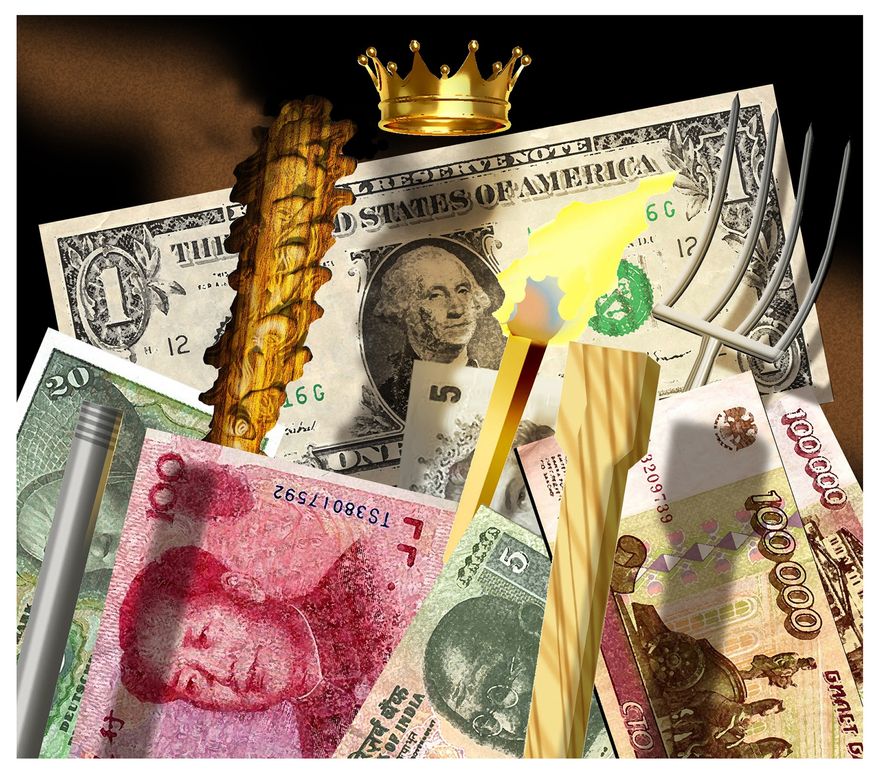Countries hostile to the U.S. and others, including China, Russia, Brazil, India, Indonesia, Argentina and South Africa, have been meeting with another to devise ways to dethrone the U.S. dollar as the world’s primary reserve currency. These and other countries are in open revolt against the “financial imperialism” of the U.S.
The following is a little background and history. A reserve currency is a foreign currency held by central banks and other monetary authorities to underwrite their international transactions and investments and to serve as a store of value for rainy days.
With the growth of the British Empire in the 18th century, the pound sterling became the world’s primary reserve currency. It remained so until 1914. The two world wars almost bankrupted Britain, and as the U.S. became the world’s largest and most important economy, the U.S. dollar increasingly became the preferred reserve currency. Most global commodity prices and most international trade are quoted in U.S. dollars.
In 1944, a conference was held in Bretton Woods, New Hampshire, to plan for the post-World War II economic order. Forty-four countries were represented. It was agreed that the U.S. would fix the value of the dollar to gold, and then other countries would peg their currencies to the U.S. dollar, thus making the U.S. dollar almost the explicit reserve currency. The system worked fine for the first couple of decades. Still, as other countries rebuilt their economies after the war and were growing rapidly, a number started exchanging their dollar holdings for gold, causing a run on U.S. gold reserves.
President Richard Nixon closed the gold window in 1971 (that is, the U.S. government stopped providing gold for U.S. dollars held by foreign governments). Even so, most governments continued to hold large amounts (on average 70% or so) of their foreign reserves in U.S. dollars. The prices of most major commodities, such as oil, copper, coffee, wheat, etc., continued to be quoted and settled in dollars.
There were many advantages to the U.S. of a global dollar-based economy. Interest paid on foreign holdings of U.S. government securities were often at rates at or even below the rate of inflation, in essence providing the U.S. with what were, in effect, interest-free loans. Many foreign nationals, not trusting their own governments, keep a significant portion of their precautionary and liquid savings in physical U.S. currency. (Many more $100 bills are held by foreigners than by Americans.) Again, these holdings, in effect, are subsidies to U.S. taxpayers (rich people in poor countries benefiting both poor and rich Americans).
When the U.S. has a period of high inflation, like now, the implicit subsidy paid (in the form of dollars with less purchasing power) to U.S. citizens by foreign holders of U.S. banknotes and securities grows rapidly. Many foreign countries do not like this state of affairs, but to date, they have found there is not much they can do about it other than some bilateral agreements for trade.
The Russians have agreed to take Chinese currency for their oil and other commodities. The Chinese have many manufactured products for the Russians to buy — from toys to high-tech products — so such an agreement has a certain logic. But even if the Chinese make several bilateral agreements with commodity-producing countries, Chinese currency is far from being a reserve currency. At the moment, Chinese currency accounts for only about 3% of international reserves, as contrasted with about 60% for the U.S. dollar (down from about 70% a few years ago).
The U.S. and other countries imposing sanctions on the Russians had the effect of freezing about half of their reserves and restricting the Russian banks’ ability to use the global “SWIFT” system. This caused panic in the Russian financial community and in other countries that fear they, at some point, could be subject to sanctions. SWIFT is the financial information system allowing banks to transact across borders.
For some other countries, including China, creating a reserve currency will be a Herculean task. Using other countries’ money as reserves is about confidence. The U.S. is losing confidence, but other countries are not gaining it. There has to be confidence that the country holding reserves is not going to seize them over some sort of dispute — as the U.S. did with Russia. Countries like Sweden, Australia and Japan know they have nothing to fear; others are not so sure.
Countries need to have confidence that the monetary authorities in the country that is holding their reserves are not going to inflate away the value. During the long period of low inflation in the U.S., there was little fear. Now, with the reckless Yellen-Powell-Biden monetary and economic policies, many probably do have some currency debasement fears — and those who are not fearful probably do not understand the situation.
Central bankers have a fiduciary responsibility to all of their citizens to protect reserves — and for most countries, despite all its problems, the U.S. dollar is still the best alternative. But if the dollar situation continues to deteriorate, more central bankers will probably diversify their holdings into other currencies and to gold, silver and other metals like aluminum and copper, and even Bitcoin.
• Richard W. Rahn is chairman of the Institute for Global Economic Growth and MCon LLC.
https://www.washingtontimes.com/news/2023/apr/3/how-to-destroy-us-dollar/
© Copyright 2023 The Washington Times, LLC.
